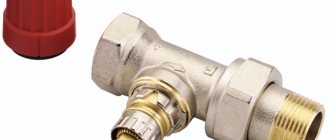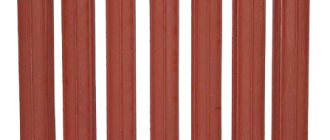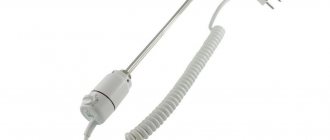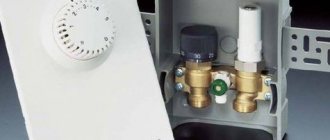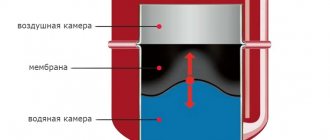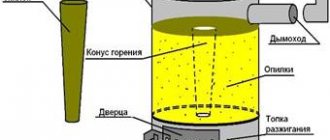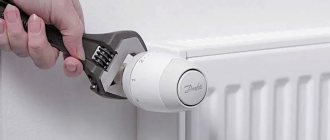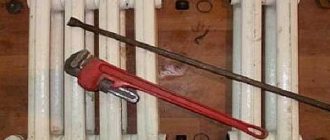The operation of the entire water floor system is based on the mixing unit, which is responsible for regulating the coolant system. This is due to the fact that moisture is supplied from the heating equipment with a fairly significant level of heating (up to 90 degrees), and in the floor surface this coefficient should be small (no more than 40 degrees). The thermal head, which is located on the damper, is responsible for maintaining normal coolant temperature.
In the mixer, a liquid is mixed, which flows at a significant temperature. As a result, it makes it possible to send it to water circuits at the required temperature.
Three way hydraulic valve
This hydraulic valve has three passages. Of these, two serve to supply water flows, the third conducts the boiler into the water circuit structure. To prevent metal corrosion, the block body is made of stainless metal. During operation, the thermal floor reacts perfectly to the environment, changing the position of the axle boxes and controlling the degree of heating of the liquid at the outlet. The thermal head is equipped with a meter that transmits signals to the actuator (close or open the valve).
It must be in a horizontal position.
Features of Three Way Valve:
- it is easy to install;
- it allows mechanical and automatic adjustment;
- it is durable;
- it has an average price;
- it contains chemical and water protection.
Two way hydraulic valve
The two-way variety is a supply valve. A special thermostatic head is placed on it, which maintains control over the temperature of the coolant. As a result, the thermal head of the water floor closes and opens the hydraulic valve, regulating the degree of supply of coolant from the boiler.
Features of this valve:
- safety and stability of floor temperature;
- constant stirring with cool liquid;
- no external recharge.
Tips for choosing
The selection of a thermostat model for a water floor depends on several circumstances: the volume of the building, boiler connection, floor covering, environmental climate, availability of additional or main heating systems.
Purchase criteria:
- Price. The most profitable varieties are mechanical type products. They perform better and are almost impossible to damage due to carelessness. Such thermostats are suitable for those who have children.
- Multifunctionality. Electronic products are excellent at controlling heat in rooms.
- Programmability. This criterion allows us to provide the most comfortable conditions in every room of the house.
Expert advice
You can install thermal valves in an apartment if there is a battery power reserve of about 30%.
When installing a thermal valve in apartment buildings, be sure to install radiator valves to be able to disconnect the battery and remove and clean the valve. In older houses, a single-pipe heating system is usually used; for them, special thermal valves are used for single-pipe systems with a large flow area.
If there are two radiators in the room, then the thermal valve can be installed on only one of them. It is practically useless to regulate the heating of cast iron radiators due to their high thermal inertia (although sometimes regulators are installed on them - see the decorative mechanical thermal valve in the photo).
Mechanical thermostat: operating principle
If the air space in the room is heated to the required level, the working sphere in the bellows expands under the influence of heat, which causes the hydraulic cylinder to straighten. The rod, combined with the bellows, rushes forward, exerting pressure on the hydraulic valve, pressing it closely against the through hole. In this case, the supply of coolant to the battery (heating) stops.
After the remaining media in the heating battery has cooled, the mixture (or gas) in the thermoelement is compressed, causing its walls to shrink, which leads to the opening of the valve. The heated coolant enters the system, then the course of action begins all over again.
Electronic thermostats
There is a minor numeric display and a row of keys. The display shows the current characteristics of the system, or those being set. The keys (often with up and down arrows) are designed to change the temperature. Programmable temperature controllers make it possible to maintain a stable floor temperature; you can automatically change it on specific days of the week or time of day.
There are modifications that, along with the stationary control unit on the wall, have a portable control panel. Certain models make it possible to manage work via a personal computer or tablet, which is quite convenient. These devices can control floor heating.
A water-insulated floor is the best heat resource; with its help, convenience and comfort are introduced into the atmosphere of the home.
You can learn more about how to ensure precise control of the temperature of a heated floor with your own hands.
Principle of operation
During the heating season, some homeowners regulate the heating temperature of radiators by partially closing the shut-off valve. This is the wrong approach, since if the fittings are used in this way, they quickly fail. Their purpose is to be in the fully open or closed position only. To be able to reduce heating costs, thermostatic heads are used for radiators.
Their operating principle is completely different. Using a scale printed on the device, the required room temperature is set. When the radiator pumps it to the specified level, the thermostat shuts off the coolant supply. This does not happen partially, but completely. As soon as the temperature drops, the supply is resumed. This is very convenient and beneficial from an economic point of view.
Head device
The thermostatic head has a certain design principle. Some models differ in additions and features laid down by the manufacturer. But the principle is the same for everyone.
The device consists of a valve and the thermostat head itself. Inside the latter there is a sealed corrugated chamber. It's called a bellows. This chamber is filled with a special substance that expands in a certain way when heated.
The system begins to put pressure on the valve stem, and it shuts off the coolant supply. The material inside the bellows can be a liquid, gas or solid. Thermostatic heads for radiators from different manufacturers are distinguished by the type of filler. The speed of the device’s response to changes in ambient temperature depends on this.
How to choose
Based on the characteristics of the heating system, as well as the conditions of its installation, various combinations of valves and thermal heads can be used to control the temperature.
So, for example, for use in single-pipe systems it is worth using valves with a higher throughput.
The same applies to those two-pipe systems in which water circulation is carried out by gravity, that is, naturally, without forced mechanisms. In cases where a two-pipe system is used where there is a circulation pump, it is recommended to choose those types of valves where it is possible to adjust the throughput.
After selecting the valve, you need to select the thermal head.
The most common options that can be purchased today are:
- having an internal thermoelement;
- electronic (which can be programmed);
- having an external temperature sensor;
- anti-vandal;
- having an external regulator.
Most often, classic thermostats with an internal sensor version are installed in cases where their axis will be in a horizontal position.
Please note: the thermostat cannot be installed vertically, as the heat emanating from the housing piping will greatly affect the bellows, causing the entire device to function incorrectly.
In addition to vertical installation options, there are also other reasons to purchase a remote version of the sensor:
- if heating radiators with a temperature regulator located on them will be located behind the curtains;
- when there is any other heat source next to the installed thermal head;
- if the location of the battery is under a large window sill.
Very often, in rooms where interior requirements are increased, batteries are covered with decorative screens. Due to this, the internal thermostat will only register the temperature that is inside this casing. In this case, access to the thermal head adjustments will be blocked. Therefore, in such cases, it is recommended to opt for a remote controller with a temperature sensor.
It’s worth knowing: if you haven’t purchased heating radiators yet, you can buy Kermi models with built-in temperature sensors.
If we talk about electronic thermostats with a display, then they come in several types; the first have a built-in control unit, and the second have a removable control unit. The latter have the peculiarity of being able to be disconnected from the thermal head, while it will continue to operate in the same mode. The purpose of such models is to regulate the temperature in different modes at different times of the day. This makes it possible to reduce the heat level during the day, and at night, when everyone in the house is sleeping, to raise it to the desired level. Due to this, it is possible to significantly save energy.
If there are small children in the family who always want to touch and twirl everything, it is recommended to install anti-vandal thermostats. This will protect the device settings from unauthorized intervention. The same situation applies to options installed in various public buildings, from kindergartens to hospitals.
The principle of economy
When purchasing the presented device, the consumer is promised savings on heating costs of up to 35%. In different cases this figure will vary significantly. Since the operating principle of the heads is to completely cut off the coolant supply, they are used only in autonomous heating systems.
Under no circumstances should you use the device if your home is quite cool. But when the room is hot, the thermostatic head will be relevant. The main economic effect of its use is observed in the off-season or when the temperature difference between day and night is quite large.
If the heating system is designed correctly, and all its elements are installed properly, the device will be quite effective. During certain periods of the heating season, the savings will be truly noticeable.
Advantages of modern thermostats
The models of thermostats that are currently produced are not only easy to use, but also have an aesthetic appearance suitable for the interior of almost any room.
It is worth noting that the installation of these devices is simple not only in new heating systems, but also in existing ones. In addition, according to experts, they have a fairly long service life, during which virtually no preventative or maintenance is required. After installing thermostats, there is no need to regulate the temperature by opening windows or doors.
Thermostat for radiator
The temperature range for normal operation of this device is 5–27 °C, you can choose the required temperature yourself and it will be maintained in the room with an accuracy of 1 °C. In addition, a thermostat installed on the radiator allows you to prevent excessive heating of the air in the room due to direct sunlight, electrical appliances or the accumulation of a large number of people.
Thermostats can not only create thermal comfort in the room, but also ensure uniform distribution of coolant throughout the entire heating system. If the device is installed on the boiler, absolutely all radiators will have the same temperature, even those that are located at the maximum distance from it.
It is worth noting that when installing a thermostat, it is best to start with those rooms in which sharp temperature fluctuations are observed, for example, a kitchen, rooms located on the sunny side, or a living room in which a large number of people can gather at the same time.
Quite often, thermostats are used in autonomous heating systems, since their installation reduces fuel costs by 25%. This, in turn, reduces the amount of harmful waste resulting from its combustion and reduces the cost of heating.
The advantages of using thermostats in a heating system are quite significant; their use can be particularly effective in private homes and cottages, because in this case, the installation of these devices pays off due to fuel savings literally in a year.
The installation of thermostats in private homes should begin with the upper floors, since there is usually a significant difference between the temperature on the lower floors and the temperature in the upper rooms.
High economic efficiency can be ensured by panel radiators that have a significant response rate to the opening and closing of the thermostat valves.
When choosing a thermostat, you should pay attention to the presence of a certificate of quality and compliance; high-quality devices always have such documents. The service life of such products reaches 20 years
Types of installation
There are two main principles of the presented device. The first option involves measuring the temperature directly on the radiator where the head is installed. This is a rather imprecise approach, but it has a right to exist.
The second option involves using a device such as a thermostatic head with a remote sensor. Temperature measurement occurs in the absence of exposure to rising heated currents from the battery. In this case, the sensor correctly determines the room temperature.
Due to this feature, the second type of installation is preferable. If the sensor is positioned correctly, the measurements will be correct. This is especially noticeable in winter, when the coolant temperature is high. Significant heat radiation comes from radiators and pipes. It can lead to errors when determining heating with a conventional head.
Installation and operation rules
Installing a thermal valve is not very difficult, but requires compliance with certain rules. This work can be easily done with your own hands.
Required tools and materials
To install modern shut-off and control pipe fittings, two adjustable wrenches of suitable diameter and FUM tape are sufficient. Some use flax or jute strands and lubricant. You will also need an American union nut.
Work progress
Before starting work, drain the coolant from the heating system. During installation, the thermal head is twisted off the valve, the stem is covered with a special cap that protects it from mechanical damage. The valve is attached to the battery using a pipe with a union nut, and to the system (radiator valve) using a separate union nut. The valve is installed in accordance with the arrow on the body indicating the direction of water flow.
The threaded connection is sealed with FUM tape. The valve is positioned so that the control head is positioned horizontally - this way it does not overheat. For a mechanical head and a head with a remote sensor, the location does not matter.
Each threaded connection is first twisted by hand, then tightened with a wrench 1-1¼ turns. When tightening the second thread, fix the first one with a key so that the valve does not change its position relative to the radiator.
The thermal valve connection diagram provides for a horizontal location of the thermal head. At the last moment before tuning, secure (in accordance with the instructions) the head on the valve. Some are secured with one push (Danfoss), some are screwed using a union nut.
Installation video
All the details of installing a thermal valve on a heating radiator can be seen in the video:
Adjusting the operation of the device
When turned on, set the regulator to minimum and fill the system. A thermometer is installed in the part of the room where residents are most often found. After about an hour or two, check the temperature in the room; if necessary, switch the thermal valve to a higher value. This is repeated until the temperature in the room reaches comfortable values. In the future, the regulator is usually not touched.
Electronic devices are programmed in accordance with the instructions.
Installation
In order for the device to work correctly, the installation of the thermostatic head must be carried out strictly according to the manufacturer's instructions. The valve is installed on the water supply pipe to the radiator. The head should not be positioned vertically, but horizontally. This will allow it to better capture the air temperature in the room.
The radiator should not be installed deep into a niche under the window sill. If the batteries are covered by a decorative panel or thick curtains, the use of a remote sensor is extremely necessary. This element should be positioned so that nothing obscures it.
The installation location must be carefully considered, otherwise an error in temperature measurement will lead to hypothermia of the room. An incorrectly installed sensor significantly reduces the speed of the device’s response to heating the air in the room. By strictly following the manufacturer's recommendations, you can carry out the installation yourself.
Design and principle of operation
Any thermostatic valve consists of the valve itself and a thermostatic head. The head contains a cylinder (also called a bellows) filled with liquid. When the temperature decreases, the liquid proportionally decreases in volume; when it increases, it increases and controls the movement of the rod that opens or closes the valve. The valve regulates the flow of hot water and heating of the radiator.
If radiators on a two-pipe heating system are installed with a bypass (jumper), then use a three-way (mixing) valve. If too hot water flows through the supply pipe or the air in the room is too warm, then the thermal head is activated, rotates the rod, the rod moves the spool, the valve works as a mixer - it mixes cold water from the bypass with the hot water and supplies it to the radiator. The heating level of the radiator decreases.
The response temperature of thermostats can be adjusted using the handle - there is a marking on it (temperature scale), and when the handle is turned by the appropriate division, the response temperature of the thermostat changes.
Device selection
The thermostatic head, the price of which depends on many parameters, comes with different bellows fillers. The cheapest varieties have a solid substance inside. Its response speed to temperature changes is quite low. Therefore, it is better not to skimp on quality and purchase more effective products. Manufacturers such as Giacomini, Purmo (500-700 rubles) use liquid as a bellows filler. Such devices quickly adapt to the conditions around them.
One of the best sellers today is the Danfoss thermostatic head, costing 1000-1500 rubles. Its work is due to the influence of a gaseous substance. When the device is installed correctly, its operation is closest to the ideal option. Gas reacts faster than other bellows fillers to changes in heating in the room. Therefore, setting up the heating system is much faster.
Having familiarized yourself with such a device as a thermostatic head, we can conclude that it is necessary for a properly designed autonomous heating system. It is better not to skimp on the quality of this device, otherwise the effect of its use will be minimal.
The article describes in detail how a thermal head works on a heating radiator, the principle of operation and installation of a thermal head on a heating radiator. Before starting work, carefully read the instructions provided. The article contains complete information to complete the work from start to finish. Choose only trusted manufacturers, do not skimp on devices, the quality is worth it!
Remote temperature sensor
The use of a remote sensor is necessary in several other cases:
- Heating radiators with thermostats are covered with thick curtains.
- An additional source of thermal energy is located in the immediate vicinity.
- The battery is located under a large window sill.
Sometimes heating radiators are covered with decorative screens. This situation is observed in rooms with increased requirements for the interior. In this case, the thermostat located inside registers only the temperature behind the decorative cladding. In addition, access to the thermal head is difficult. To solve the problem, install a thermal head for a heating radiator with a remote sensor.
As for programmable devices, they are equipped with displays for visual control and are also divided into two types. Some of them are equipped with a built-in control unit, while others have this element removable. The second option has some advantage: the disconnected control unit continues to operate in the same mode
At the same time, it is important to control how the thermal head on the heating radiator works
Such models allow you to adjust the temperature individually for a specific situation. For example, during the day you can reduce the temperature values, and at night - increase them. The resulting savings are quite significant.
Current devices are ideal for homes where there are small children who touch and twirl everything
Therefore, it is important to know and understand how to install a thermostatic head on a radiator
Temperature regulators of this type do not allow the settings to be reset if handled carelessly. This option is also used in public buildings, including kindergartens and hospitals.
This option is also used in public buildings, including kindergartens and hospitals.
Thermostatic head operating principle
- The main sensor is a bellows, in which the liquid or gas is under a certain pressure. The adjustment spring is responsible for balancing the device, which compresses the bellows when we set the temperature we need by rotating the rotary handle.
Note! The better the calibration of the device, the more accurately it will respond to temperature changes. At the same time, the price of such high-precision thermal heads will be appropriate.
- As the temperature rises, the volume of the bellows increases (mainly due to gas expansion or partial evaporation of the working fluid).
- An increase in the volume of the bellows leads to the fact that the spring fixing the rod is released, and the valve gradually closes the gap in the pipe.
- This continues until equilibrium is established inside the device, or until the radiator valve under the thermal head is completely closed, i.e. the rod will not go to its lowest position.
Models with remote elements work according to a similar scheme. The only difference is that either special programmable devices (climate control systems) or remote sensors (liquid, gas or electronic) react to temperature changes. Only after this the information reaches the thermal valve mechanism and activates the rod.
How to choose a thermal head
Thermostatic devices are produced by many manufacturers.
To make the right choice, you need to be guided by the following criteria:
Thermal valve to which the head will be attached
Since the connection can be clip or threaded, you need to pay attention to this point. If the manufacturer is the same, there will be no problems. View of the threaded connection on the head itself
It can be in the form of a nut with curtains or simply round. In the first case, during installation you need an additional tool to crimp the connection. In the second, everything is much simpler. The presence of a “skirt”. The head looks better with it, because... it covers the work area. Material of manufacture. The cheapest are thermal heads in a plastic case. Expensive models have a metal body. Quality of plastic. Some manufacturers, in order to reduce the cost of their products, use the cheapest type of plastic. The strength of the structure suffers from this, and over time the plastic turns yellow and loses its aesthetic appearance. Work item type. The choice will have to be made between liquid, gas, electronic and paraffin. Smooth rotation. The handle should rotate smoothly. This is a sign of good quality. Any cracking, squeaking or jamming indicates a not entirely high-quality product. Graduation and scale length. For most models it is in the range of +5 – +30 °C. If the graduation scale is located around the entire perimeter of the head, it can quickly wear out. Availability of anti-vandal casing. It protects against unauthorized access to settings. Design. Since thermal heads are mainly located in plain sight, their appearance and color scheme are important.
It is not necessary to purchase a ready-made kit consisting of a thermal valve and a thermal head. These devices can be purchased separately.
The gas-filled bellows is not too sensitive to external heat sources. This is a definite plus, but its cost is much higher than that of a liquid bellows
A thermal head equipped with automation benefits a lot, but it is not always effective. There is no point in mounting it on cast iron radiators. This material is very heat-intensive, and since the mass of the battery is large, it has great inertia. Only a manual type of head can work correctly here.
Installing a thermal head on a heating radiator
Before starting work, it is important to know how to correctly install the thermal head on the radiator; the further functionality of the device will depend on this.
What you need:
- Thermal head
- Thread cutting die
- Fumlenta
- Two adjustable wrenches
- Locknuts
Preparatory work
Typically, the installation of a thermal head on a battery is carried out together with the installation of new radiators. To do this, you need to shut off the riser and drain the remaining coolant in the pipes into a bucket. It is best to carry out work outside of the heating season.
Choosing a location for installing the thermal head
Taking into account the errors in installing the thermostatic head, which we discussed above, we can draw conclusions about where exactly the thermostatic head should not be installed. What will be the best options? It is important that it is not exposed to heat flows from the radiator and is not affected by factors that can cause a false perception of temperature.
The photographs below show common options for correctly installing the thermostatic head on batteries. If it is mounted at the top of the radiator, it should only be positioned horizontally. In the lower part it can be mounted horizontally and vertically, since there are no strong thermal flows of heated air - it rises to the top.
Carving pipes
To secure the head to the radiator, it is necessary to cut threads at the attachment points. To do this, threads are cut using a die on the pipes coming from the riser and radiator.
Head mounting
A lock nut is screwed to the outlet coming from the riser. It is wrapped with fumlenta, and the thermostat is screwed onto it, but the fasteners are not tightened. Next, do the same with the flow coming from the radiator. The installed thermal head must be secured - simultaneously tighten both nuts with two adjustable wrenches.
What is it and what is it for?
Thermal valve (thermal valve, thermal head) is a type of pipeline fittings that is used to regulate the temperature of the coolant in the heating device. A radiator regulator is a compact device that automatically regulates the temperature of the water supplied to a separate radiator.
Purpose and scope
The thermal valve serves to regulate the temperature in each individual radiator. In fact, to cool the coolant entering the radiator. The thermal valve acts as a kind of balancing valve for each battery. Reducing the water temperature in the radiator reduces heating of the radiator, the room and saves fuel. In some cases, the temperature is limited so that you cannot get burned on the radiator (in children's rooms, for example).
Particularly worth mentioning is the use of thermostats in underfloor heating systems. The operating temperature of water in such heating systems should not exceed 50 °C, therefore a mixture of cooled coolant from the return pipeline and hot water from the heating boiler is usually supplied to the underfloor heating system.
In private homes, a thermal valve saves heating costs, especially if some of the rooms are not used every day.
In apartment buildings, regulators with a thermal head are relevant if the heating is often excessive and the apartment becomes hot. If the heating is weak, no regulators will warm up the battery, and can only worsen the situation. So before installing thermal heads, you should think about how often it’s hot in your home?
In any case, installing thermal valves in an apartment does not affect heating bills, and short-term excessive heating of the radiators can be regulated by covering them with a blanket or blocking them with thick packaging cardboard (as an option, opening the windows and creating a draft). Installing regulators is a financial waste and an extra threaded connection is an additional place for a possible leak.
Characteristics
Thermal valves are characterized by a range of operating temperatures, control method (manual or automatic), working medium in the bellows, nominal diameter (the amount of hydraulic losses at the valve depends on this), shape and installation method. And design - there are possible options, sometimes very interesting.
Standard sizes of radiators for radiators are with a nominal bore of 15 and 20 mm (½" and ¾"). Maximum operating pressure – up to 1 MPa (10 atm).
What materials are they made from?
Thermostats for heating radiators are made of stainless steel, bronze and brass. These materials are strong, durable, and corrosion resistant. Almost all products sold commercially are made of brass or plated brass (chrome, nickel or MX mixture). The handles are made of plastic. Cast iron and carbon “black” steel are not used; copper is too soft for shut-off and control valves.
Types of thermal heads
All produced thermal heads can be divided into two types:
• mechanical, which is adjusted manually;
• electronic, controlling the adjustment process in automatic mode.
Mechanical models are a small head with a rotary handle. The temperature range that can be controlled starts at +7° and goes up to +28°. The device provides several operating modes. Each division of the temperature scale is equivalent to 2-5 degrees.
In electronic models, the entire adjustment process is automated. The adjustment accuracy corresponds to 1-2 degrees. A flexible control system allows you to set the most suitable heating mode.
Setting up the thermal head
After the user has become familiar with the design of the device and learned how the thermal head on a heating radiator works, setting the optimal microclimate in each room is not difficult. By rotating the handle relative to the scale with marks, you can adjust the temperature within +5 – +28 degrees.
In the first case, the system is guaranteed not to freeze in the absence of the owners inside the periodically operating building. The maximum value is considered comfortable for users. The substance with which the bellows chamber is filled reacts to an increase/decrease in temperature within 1 degree. Therefore, the valve will cycle on/off regularly.
Thus, any home craftsman can select and install a thermal head together with a valve. To do this, it is enough to take into account the above factors and avoid basic installation errors.
The thermal head is used in 90% of cases to lower the air temperature. However, in a country cottage, by installing heads with valves on all registers, the temperature can be raised. In the rooms farthest from the boiler, heat loss in the heating circuit is maximum. Therefore, when the supply to nearby registers is shut off, hot water better heats those furthest from the boiler room.
Thermal heads for radiators
Modern heating systems today cannot do without additional thermoregulation elements. Buying a thermal head for a radiator means significantly reducing heating costs and automatically maintaining a comfortable temperature in the room.
The principle of operation of the thermal head
What valves are used with?
How to install a thermal head?
Types of thermostatic heads
What types of radiators can be installed on?
Which manufacturer's thermal head is better?
The principle of operation of the thermal head
The principle of operation is very simple, but it differs depending on the specific type, for example: together with a flow valve, it only regulates the amount of coolant passing through the radiator, and the thermal head, used in conjunction with three and four-way valves, also mixes the heated liquid with chilled. The decision to use thermal heads should be made based on the specific layout of the heating system of your home, and buying thermal heads for radiators will not be difficult - they are presented in large quantities on the market, and in our online store.
Thermal heads cannot be used directly without the valve itself, that is, the valve, and the mechanism that influences the valve stem. They are divided into devices with manual adjustment of the required temperature and programmable ones, which can maintain different temperatures for different periods of time.
Control of the temperature in the room can be carried out in two ways: manually or, which is extremely convenient, automatically. Thermal heads for radiators operate in automatic mode, because... are equipped with a special bellows that functions as a determinant of the current room temperature. A bellows is a sensitive element, usually cylindrical in shape, filled with a special liquid. When the air temperature in the room changes, the volume of liquid in the sensing element changes and, accordingly, the pressure in it. A change in pressure entails a change in the geometric dimensions of the sensing element, which is transmitted to the valve shutter through the connecting rod, thus regulating the flow of coolant to the heating radiator.
What valves are thermal heads used with?
Radiator thermal heads are used with two-way, three-way and four-way valves. Two-way thermostats are also called walk-through thermostats because... they have two outlets and are connected to only one pipe of the heating system. Heating systems equipped with thermal heads with three-way valves have wider capabilities - they not only block access to the coolant, but also mix colder water from the return into the radiator circuit. As a result of mixing the flows, the heating temperature of the radiator decreases. There is a division into thermal valves with pre-set resistance and thermal valves without this setting. The second option allows you to achieve equal coolant flow rates for all heating devices.
How to install a thermal head?
Installing thermostatic heads will allow you to achieve optimal results from the operation of heating radiators, however, it is extremely important to ensure that they are installed correctly: it is necessary to ensure free circulation of air in the immediate vicinity of the device sensor, to exclude the possibility of heating elements affecting the sensor, otherwise the real room temperature will not correspond to the set values on the sensor .
The thermal head on the heating radiator is mounted in a horizontal position (parallel to the floor) on the supply part of the radiator pipeline. In addition, the arrow on the body of the thermostatic head must coincide with the direction of coolant flow. It should not be exposed to heat sources or direct sunlight, and should not be covered with decorative elements of the interior, since this distorts the measured air temperature and the thermostat cannot effectively perform its functions. If a different location of the thermal head is not possible, then special remote sensors are used to achieve the greatest accuracy of the maintained temperature in the room. As a rule, a shut-off valve is installed on the “return” of the radiator, which, if necessary, will allow dismantling or cleaning of the battery without disconnecting the entire heating system from the riser, and also performs the function of primary balancing of the radiator coolant flow. After the end of the heating season, the thermostat must be fully opened by turning the thermal head handle counterclockwise, which will prevent the formation of sediment on the valve seat.
Types of thermostatic heads:
Thermal head for heating radiator
A standard thermostatic heating radiator head is installed on the radiator valves and regulates the volume of coolant entering this heating device.
If the temperature in the room has reached the value set on the thermal head, it begins to block the access of coolant to the radiator, which leads to a decrease in the output of thermal energy by a particular device. When the temperature drops below the set value, the thermostatic head, by moving the rod, increases the cross-section of the passage channel of the radiator valve, which leads to an increase in the volume of incoming coolant and accordingly increases the heat transfer of the heating device. The user ultimately gets the opportunity to comfortably adjust the temperature in the room and save about 15-20% of thermal energy.
There are a large number of different thermostatic radiator heads on the Russian market, and it is quite difficult for the user to understand the choice of the optimal option. The main selection criteria should be: a reliable and well-known manufacturer, minimal inertia, design, operational reliability. If a thermal head for radiators has a low price, then this should alert the buyer, since purchasing such a head may be absolutely useless. The seat for most heads is usually standard - for M 30*1.5 thread and must be made of reliable materials.
Thermal head with attached sensor
The use of an overhead sensor is necessary in cases where the radiator with a thermostatic head is covered with foreign objects (decorative grille, curtain, etc.) and the operation of the thermal head will be incorrect due to the thermal “limitation” of the space around it. Using an overhead sensor, you can set the location of the temperature “receipt” for the thermal head. The sensor is usually mounted on the wall and controls the operation of the head through a capillary tube. Read more: Caleffi...
The development of this technology was the appearance of thermostatic heads with a remote control knob. The control device is also located outside the radiator zone and allows you to regulate the temperature in the room without access to the thermal head. Read more: Caleffi...
Thermal head with remote sensor
The use of thermostatic heads with remote sensors is most often justified if a water “warm floor” heating system is used in a house or apartment.
If a radiator thermostat does an excellent job of maintaining the temperature in the room, then in a heated floor system it is necessary to regulate the temperature of the heated surface, which is very problematic to do using a simple room thermostat. For underfloor heating systems, it is important to maintain a temperature of 25-26 degrees, this is the optimal indicator for a comfortable stay in the room and, what is important, this floor temperature will not lead to cracking of the screed due to the high temperature of the coolant. To do this, a thermal head with a remote sensor is installed on a three-way valve, and a remote sensor is fixed to the pipe. Read more…
Electronic thermal heads
Recently, electronic thermal heads with touch or liquid crystal screens have become widespread, providing increased accuracy in maintaining the temperature in the room and virtually eliminating human participation in the adjustment process.
Another important advantage of such electronic thermal heads is their “zero” inertiality, since the heat transfer of the radiator is adjusted immediately after a change in room temperature (for conventional thermal heads it takes about 20-40 minutes).
Programming by day of the week allows you to configure this head to suit any heating needs of the client on different days, which leads to significant savings on heating.
Wireless thermal heads
Wireless thermal heads are controlled by a room thermostat or heating control panel via radio or wireless network. This ensures increased accuracy of regulation, the ability to control the temperature in a room with several radiators from one device (or adjust the temperature in different rooms using a single controller), setting daily or weekly tasks for the room’s thermal system. This is another step towards creating smart home heating systems. Manufacturers: Caleffi, Oventrop, Comap, Frontier, Salus.
Control of a heating radiator using radio-controlled thermostatic heads is carried out according to two principles: 1. The heating control panel is located in a convenient place for the user (near the front door or in the central room) and with its help the user sets the required temperature in the rooms. At the same time, the heating radiator control panel does not record the temperature, but only gives commands to maintain it. Having received the information, the thermostatic remote control head begins to “analyze” the temperature around itself and, depending on the data received, opens or closes the radiator valve. In this case, the wireless thermal head acts as an “actuator” that regulates the temperature according to the set parameters and data from the sensor built into it. For example, the Caleffi system. 2. The wireless head is controlled according to data from a thermostat located directly in the controlled room. The thermostat “takes” temperature readings at the location of its installation and commands the remote control thermostatic head to operate by dissipating heat from the radiator. For example, the Frontier , Salus system. These radiator heating systems are very convenient, especially in houses controlled using GSM smartphones, since it is often impossible to connect several temperature sensors to a GSM receiver. The presence of wireless thermal heads helps the user configure the precise operation of each of them, without spending a lot of time on this procedure, and also get real comfort, due to their low inertia and the presence of external sensors.
Salus Controls has truly made a technical breakthrough by releasing the Salus iT600 smart home heating system, which uses wireless thermal heads for radiators as one of its elements .
What types of radiators can thermal heads be installed on?
It can be mounted on bimetallic, steel and aluminum batteries, but it is not recommended to install on cast iron batteries due to the high thermal inertness of this alloy.
Which manufacturer's thermal head is better?
There are several undisputed leading companies in the market of thermostats for heating radiators: the British Salus Controls, the Danish Danfoss, the Italian Caleffi and the German Oventrop, whose product range is simply amazing with the abundance of a wide variety of models. Thermal heads from these manufacturers have excellent quality and reliability, the choice is yours, it all depends only on your needs and financial capabilities.
Buy radiator thermal head CALEFFI
Our specialists will help you select and mount the Thermal Head on the radiator and will find an acceptable solution at a price. You will be satisfied by cooperating with us!
